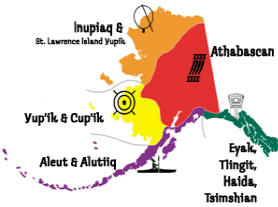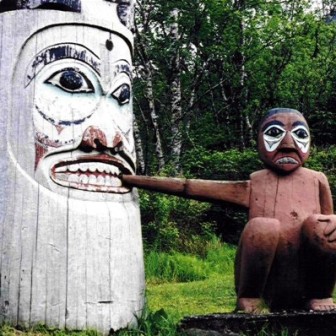|
Alaska Natives are the indigenous peoples of Alaska. They include: Aleut, Inuit, Tlingit, Haida, Tsimshian, Eyak, and a number of Northern Athabasca cultures. Alaskan natives in Alaska number about 119,241 (as of the 2000 census). There are 229 federally recognized Alaskan villages and five unrecognized Tlingit Alaskan Indian tribes.
Occupying the islands and mainland of southeast Alaska are the northernmost groups of the Northwest Coast cultures; the Tlingit and Haida Indians. They are well-known for their distinctive art represented in totem poles and other elegantly carved objects. The Tlingit and Haida are more similar to Indians along the coast of present day British Columbia than to other Alaskan groups. The Tlingit occupied the vast majority of the area from Yakutat Bay to Portland Canal while the Kaigani Haida, whose Haida relatives occupied the Queen Charlotte Island off the north coast of British Columbia, controlled the southern half of the Prince of Wales archipelago. The two groups share similar social and cultural patterns; however, their languages are unrelated and they have distinct ethnic identities.
The Tlingit are also known as Kolosh and lived in three groups including the Yehl or Raven, Goch or Wolf, and Nehadi or Eagle. Since the Nehadi were a small group, some researchers leave out this group of the Tlingit. Each of these groups usually consisted of over twenty clans. The clans may have contained two or more villages which was further divided into house groups which contained a number of families.
The clans of the Tlingit Indians and the family groups were given their status based on the wealth, character, and ancestors of their members. The oldest male was the head of the family group. The family head with the highest status was the leader of the clan. There were no village leaders and disputes were mediated by the clan heads.
The Tlingit homes were a large rectangle with cedar planks set along the sides and upon a low-sloping, peaked roof held up by four decorated corner posts and a ridge beam. Inside, the floor was dug down so the sides of the house could hold two or more levels of benches, a platform where people sat and a higher one divided by wooden partitions into sleeping compartments.
On the beach in front of the house were canoes, sheds for smoking fish, drying racks, and work areas.At the rear of each house, before or inside its secluded storeroom holding sacred treasures, lived the members of the nobility who owned that house. Their eldest man was the leader of the household, but his mother and sisters provided the links among all the members. Along the sides lived families of commoners who attached themselves to that house as kin or labor. Beside the oval front door slept slaves, taken in war or the children of such captives, whose lives belonged to their owner, along with all their efforts. Along the sides of the house where they lived, families kept their own open fires for cooking and heating.
The Tlingit Indians are known for their elaborate ceremonies. One of the more well known ceremonies was the potlatch which was usually performed out of respect for the dead. These ceremonies traditionally lasted for four days. They consisted of dances, songs, performances, gifts, and a feast which were hosted by one group for another.
According to coastal Indians, Orca was created by the hunter who carved a "blackfish" out of yellow cedar and commanded it to kill his wicked in-laws. Orca tore the men to bits and returned to the Tlingit man, Natsalane, who then ordered the sleek animals never again to prey on humans. And, to this day, Orca, the top predator of the sea, doesn’t eat people. Indeed, the Tlingit people of southeast Alaska consider Orca a custodian of the sea.
Since the Tlingit lived on the coast, their subsistence was derived mainly from the sea. Seals and fish such as halibut, salmon, and herring were caught with hooks, basketry traps, and spears. Hunting supplemented fishing, but hunting was done primarily for furs. Bears were rarely killed, since they were thought to be closely related to human beings.
The Tlingit were sedentary most of the year, but during the summer they led a semi-nomadic life. It was also during the summer that most of the subsistence activity was carried on, and the people left the villages for camps in their hunting and fishing territories. The winter was devoted to household activities, such as weaving. Winter was also the ceremonial season.
|




